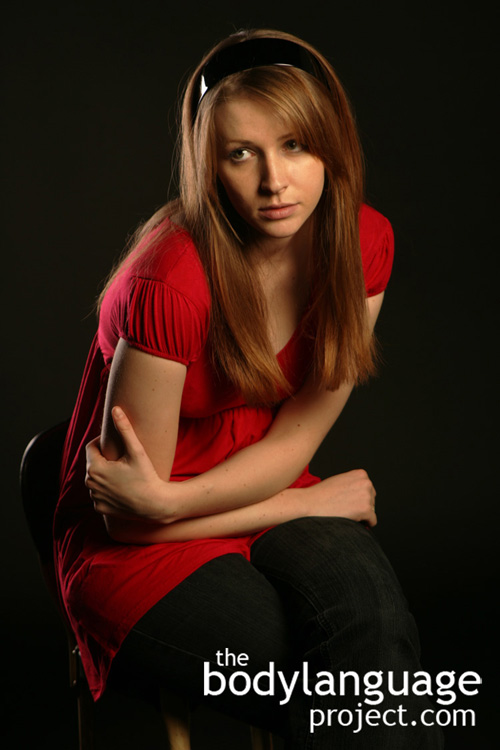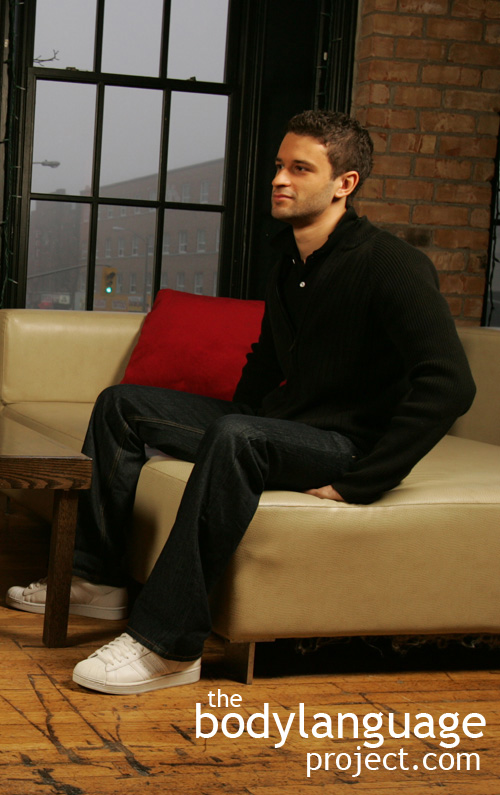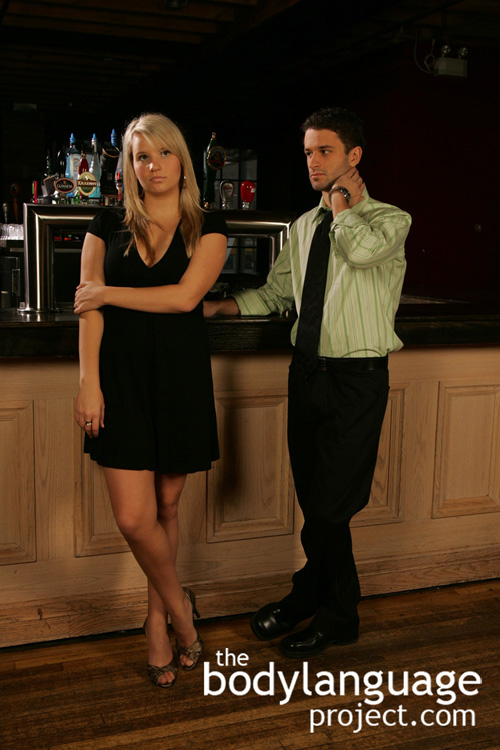The Body Language of Body Lowering or Body Shrinking
Synonym(s): Body Shrinking, Lowering The Body, Shrinking The Body,
Description: A technique whereby a person takes a lower position relative to another which can include the overall body and posture, the head shrunk into the shoulders, sitting down from a standing position and so forth.
In One Sentence: Body lowering signals a desire to shrink the body’s overall size to appear more submissive.
How To Use it: Use body lowering to signal that one is willing to relinquish dominance to another person. In a dating context, a man might lower himself so that he can match his female partner’s eye level and build intimacy rather than tower over and dominant her. A boss might lower himself to the level of an employee to build trust. A server might crouch down at the edge of the table while taking orders. This can help build trust between him and his patrons giving him a shot at a higher tip. As body lowering also shrinks the size of the overall profile it can reduce punishment by appearing more submissive. It can also allow a person to fly under the radar when avoiding being called on such as in a classroom situation. Use body lowering when you want to build trust, show submission, and hide in plain sight.
Context: a) Social, b) Dating, c) Business
Verbal Translation: a) “I’m lowering my body, cowering, so that you don’t see me as a threat and won’t punish me so severely.” b) “I’m lowering my body so that you don’t see me as a threat and protect me, care for me, or give something to me” c) “I don’t want to be called upon so I’m going to slink down in my chair, head down – I don’t know the answer to this question.”
Variant: See Body Raising, Bow and Body Bend, Sinking In The Chair. The curtsey, bow and body bend are examples of body lowering that shows a willingness to submit to the audience and accept their adulation. Some churches also accept a curtsey went entering a pew.
Cue In Action: a) When pulled over by the cops, Jake shrunk down in his shoulders, propped himself against his car with his legs bent at the knee, head drooping. b) Deborah was beginning to like Jeff and whenever she and he were standing next to him, she shrunk her body and melted into his by placing her head down against his chest.
Meaning and/or Motivation: A technique whereby a person takes on a lower position relative to another. This implies that a person wishes to take on a lesser role by submitting and receive care and authority passively from another (this person is more dominant).
Status and dominance are closely related to the relative height of a person which is why people are naturally seen as needing protection when shorter and conversely, naturally as leaders when they are taller.
Height can be artificially reduced by sitting, standing at the bottom of a staircase, slouching, drooping the head and so forth.
Tall men and women might find their posture suffers because they tend to slink down to fit in with the rest of the crowd rather than standing tall. All techniques indicate the desire to reduce overall size so as not to appear threatening.
Cue Cluster: Body lowering is usually associated with other submissive cues such as head lowered and eye contact avoidance. However, in dating, women may couple eye contact with body lowering so as to take a submissive role to appease and flirt with men.
Body Language Category: Appease, Defensive, Fearful body language, Low confidence body language, Nonthreatening body language, Readiness to submit postures, Submissive body language.
Resources:
Aviezer, Hillel; Ran R. Hassin; Jennifer Ryan; Cheryl Grady; Josh Susskind; Adam Anderson; Morris Moscovitch and Shlomo Bentin. Angry, Disgusted, or Afraid? Studies on the Malleability of Emotion Perception. Psychological Science. 2008. 19(7): 724-732.
http://bodylanguageproject.com/articles/emotions-read-context-study/
Aggarwal, Pankaj and Min Zhao. Seeing the Big Picture: The Effect of Height on the Level of Construal. Journal of Marketing Research, forthcoming; 2014
http://bodylanguageproject.com/articles/height-embodies-thinking-height-marketing/
Boyson, A. R., Pryor, B., & Butler, J. (1999). Height as power in women. North American Journal of Psychology, 1, 109–114.
Burgoon, J. K., & Hoobler, G. (2002). Nonverbal signals. In M. L. Knapp & J. A. Daly (Eds.), Handbook of interpersonal communication (3rd ed., pp. 240–299). Thousand Oaks, CA: Sage.
Burgoon, J. K., Johnson, M. L., & Koch, P. T. (1998). The nature and measurement of interpersonal dominance. Communication Monographs, 65, 308–335.
Bohns, Vanessa K. and Scott S. Wiltermuth. It Hurts When I Do This (Or You Do That): Posture And Pain tolerance. Journal of Experimental Social Psychology. 2012. 48: 341-345.
http://bodylanguageproject.com/articles/dominant-and-submissive-postures-affects-more-than-public-perception-it-also-affects-felt-pain-and-physical-strength/
Brin, Pablo and Oli Richard. Body Posture Effects On Self-Evaluation: A self-Validation Approach. European Journal of Social Psychology. 2009; 39: 1053–1064.
Carney, D. R., Hall, J. A., & LeBeau, L. S. (2005). Beliefs about the nonverbal expression of social power. Journal of Nonverbal Behavior, 29, 105–123.
Cashdan, Elizabeth. Smiles, Speech, and Body Posture: How Women and Men Display Sociometric Status and Power. Journal of Nonverbal Behavior. 1998. 22(4): 209-228.
Ellis, L. (1994). The high and the mighty among man and beast: How universal is the relationship between height (or body size) and social status? In L. Ellis (Ed.). Social stratification and socioeconomic inequality (Vol. 2, pp. 93–111). Westport, CT: Praeger Publishers.
Eddie Harmon-Jones and Carly K. Peterson. Supine Body Position Reduces Neural Response to Anger. Association for Psychological Science. 2009; 20 (10): 1209-1210.
http://bodylanguageproject.com/articles/supine-body-posture-reduces-aggression/
Flack, William F., Jr. Peripheral Feedback Effects of Facial Expressions, Bodily Postures, and Vocal Expressions on Emotional Feelings. Cognition and Emotion. 2006. 20 (2), 177-195. DOI:10.1080/02699930500359617
http://bodylanguageproject.com/articles/body-and-facial-expressions-influence-mood/
Girard, Jeffrey M.; Jeffrey F. Cohna; Mohammad H.Mahoor S.; Mohammad Mavadati;
Zakia Hammal; and Dean P. Rosenwalda. Nonverbal Social Withdrawal In Depression: Evidence From Manual And Automatic Analyses. Image and Vision Computing. 2013.
http://bodylanguageproject.com/articles/body-language-signals-withdrawal-depression
Kimbrell, G. Relationship of the upright agonistic posture in the foot shock situation to dominance-submission in male C57BL/6 mice. Psychonomic Science. 1969. 16(3): 167-168.
Kret, M. E. and B. de Gelder. When a Smile Becomes a Fist: The Perception of Facial and Bodily Expressions of Emotion in Violent Offenders. Exp Brain Res. 2013. 228: 399-410. DOI 10.1007/s00221-013-3557-6.
http://bodylanguageproject.com/articles/reading-bodily-postures-facial-expressions-incorrectly-can-disastrous-just-ask-violent-offenders/
Katza, Carmit; Irit Hershkowitz; Lindsay C. Malloya; Michael E. Lamba; Armita Atabakia and Sabine Spindlera. Non-Verbal Behavior of Children Who Disclose or do not Disclose Child Abuse in Investigative Interviews. Child Abuse & Neglect. 2012. 36: 12-20.
http://bodylanguageproject.com/articles/reading-nonverbal-behaviour-child-abuse-cases-encourage-children-divulge-information-truth-telling
Li Huang, Adam D. Galinsky, Deborah H Gruenfeld and Lucia E. Guillory. Powerful Postures Versus Powerful Roles: Which Is the Proximate Correlate of Thought and Behavior? 2011, Psychological Science; 22(1): 95–102.
http://bodylanguageproject.com/articles/whats-more-powerful-nonverbal-power-or-real-power/
Navarro, Joe. 2008. What Every BODY is Saying: An Ex-FBI Agent’s Guide to Speed-Reading People. William Morrow Paperbacks.
Marsh, Abigail A; Henry H. Yu; Julia C. Schechter and R. J. R. Blair. Larger than Life: Humans’ Nonverbal Status Cues Alter Perceived Size. PLoS ONE. 2009. 4(5): e5707. doi:10.1371/journal.pone.0005707.
http://bodylanguageproject.com/articles/large-life-nonverbal-dominance-affects-perception-size/
Marsh, Abigail A; Karina S. Blair; Matthew M. Jones; Niveen Soliman, and R. J. R. Blair. Dominance and Submission: The Ventrolateral Prefrontal Cortex and Responses to Status Cues Journal of Cognitive Neuroscience. 2009. 21:4, pp. 713–724.
Meier, B. P., Hauser, D. J., Robinson, M. D., Friesen, C. K., & Schjeldahl, K. (2007b). What’s ‘up’ with God?: Vertical space as a representation of the divine. Journal of Personality and Social Psychology, 93, 699–710.
Meier, B. P., & Robinson, M. D. (2004). Why the sunny side is up: Associations between affect and vertical position. Psychological Science, 15, 243–247.
Meier, B. P., & Robinson, M. D. (2005). The metaphorical representation of affect. Metaphor and Symbol, 21, 239–257.
Meier, B.P., Robinson, M.D., & Caven, A.J. (in press). Why a big mac is a good mac: Associations between affect and size. Basic and Applied Social Psychology.
Melamed, T. (1992). Personality correlates of physical height. Personality and Individual Differences, 13, 1349–1350.
Middleton, W. C., &Moffett, D. C. (1940). The relation of height and weight measurements to intelligence and to dominance-submission among a group of college freshmen. Research Quarterly of the American Association for Health, Physical Education, and Recreation, 11, 53–59.
Montepare, J. M. (1995). The impact of variations in height on young children’s impressions of men and women. Journal of Nonverbal Behavior, 19, 31–47.
Matsumura, Shuichi ; Hayden, Thomas J. When should signals of submission be given?–A game theory model. Journal of Theoretical Biology. 2006. 240(3): 425-433.
Mehrabian, Albert Holzberg, Jules D. (editor). Inference of Attitudes From the Posture, Orientation and Distance of a Communicator. Journal of Consulting and Clinical Psychology. 1968. 32(3): 296-308.
Mehrabian, Albert Deese, James (editor). Significance of posture and position in the communication of attitude and status relationships. Psychological Bulletin. 1969. 71(5): 359-372.
Matsumoto, D., & Willingham, B. (2006). The thrill of victory and the agony of defeat: Spontaneous expressions of medal winners of the 2004 Athens Olympic Games. Journal of Personality and Social Psychology, 91(3), 568–581.
Mouterde, S. C., Duganzich, D. M., Molles, L. E., Helps, S., Helps, R., & Waas, J. R. (2012). Triumph displays inform eavesdropping little blue penguins of new dominance asymmetries. Animal Behaviour, 83, 605–611.
Nelson, Nicole L. and James A. Russell. Preschoolers’ Use of Dynamic Facial, Bodily, and Vocal Cues to Emotion. Journal of Experimental Child Psychology. 2011; 110: 52-61.
http://bodylanguageproject.com/articles/children-read-body-language-study/
Oosterwijk, Suzanne; Mark Rotteveel; Agneta H. Fischer and Ursula Hess. Embodied Emotion Concepts: How Generating Words About Pride and Disappointment Influences Posture. European Journal of Social Psychology. 2009. 39: 457–466. DOI: 10.1002/ejsp.584
http://bodylanguageproject.com/articles/embodiment-nonverbal-posture-thinking-pride-shame-literally-changes-body-language/
Oosterwijk, S., Rotteveel, M., Fischer, A. H., & Hess, U. Embodied emotion concepts: How generating words about pride and disappointment influences posture. European Journal of Social Psychology. 2009. 39, 457–466.
Pitterman, Hallee ; Nowicki Jr, Stephen. A Test of the Ability to Identify Emotion in Human Standing and Sitting Postures: The Diagnostic Analysis of Nonverbal Accuracy-2 Posture Test (DANVA2-POS). Genetic, Social, and General Psychology Monographs. 2004. 130(2): 146-162.
Prieto, A. G., & Robbins, M. C. (1975). Perceptions of height and self-esteem. Perceptual and Motor Skills, 40, 395–398.
Park, Lora E.; Lindsey Streamer; Li Huang and Adam D. Galinsky. Stand Tall, But Don’t Put Your Feet Up: Universal and Culturally-Specific Effects of Expansive Postures On Power. Journal of Experimental Social Psychology. 2013; 49: 965–971.
http://bodylanguageproject.com/articles/are-expansive-postures-of-power-universal-or-cultural/
Pablo Brin and Oli Richard. Body posture effects on self-evaluation: A self-validation approach. European Journal of Social Psychology. 2009; 39: 1053–1064.
http://bodylanguageproject.com/articles/posture-affects-confidence-of-thoughts/
Pablo Briñol; Richard E. Petty and Benjamin Wagner. Body Posture Effects on Self-Evaluation: A Self-Validation Approach. European Journal of Social Psychology. 2009. 39(6): 1099-0992. DOI: 10.1002/ejsp.607.
http://bodylanguageproject.com/articles/fix-posture-fix-confidence/
Rule, Nicholas, O.; Reginald B. Adams Jr.; Nalini Ambady and Jonathan B. Freeman. Perceptions Of Dominance Following Glimpses Of Faces And Bodies. Perception. 2012; 41: 687-706 doi:10.1068/p7023
http://bodylanguageproject.com/articles/people-can-read-dominance-split-second
Richards, Lynne ; Mcalister, Laurie. Female Submissiveness, Nonverbal Behavior, and Body Boundary Definition. The Journal of Psychology. 1994 128(4): 419-424.
Robinson, Michael D. ; Zabelina, Darya L. ; Ode, Scott ; Moeller, Sara K. The vertical nature of dominance-submission: Individual differences in vertical attention. Journal of Research in Personality. 2008. 42(4): 933-948.
Sturman, Edward D. Involuntary Subordination and Its Relation to Personality, Mood, and Submissive Behavior. Psychological Assessment. 2011. 23(1): 262-276 DOI: 10.1037/a0021499
http://bodylanguageproject.com/articles/nonverbal-submission-men-women-depression-critical-examination-use-disuse-submission/
Scarpa, Stephano; Alessandra Nart; Erica Gobbi and Atillo Carraro. Does Women’s Attitudinal State Body Image Improve After One Session Of Posture Correction Exercises? Social Behavior and Personality. 2011; 39(8): 1045-1052.
Schubert, T. W. (2005). Your highness: Vertical positions as perceptual symbols of power. Journal of Personality and Social Psychology. 89. 1–21.
Schwartz, B., Tesser, A., & Powell, E. (1982). Dominance cues in nonverbal behavior. Social Psychology Quarterly, 45, 114–120.
Stepper, S., & Strack, F. (1993). Proprioceptive determinants of emotional and nonemotional feelings. Journal of Personality and Social Psychology, 64, 211–220.
Schenkel, Rudolf. Submission: Its Features and Function in the Wolf and Dog. American Zoologist. 1967. 7(2): 319-329.
Tiedens, Larissa Z ; Fragale, Alison R. Power moves: complementarity in dominant and submissive nonverbal behavior. Journal of personality and social psychology. 2003. 84(3): 558-68.
Tracy, J. L., & Matsumoto, D. (2008). The spontaneous expression of pride and shame: Evidence for biologically innate nonverbal displays. Proceedings from the National Academy of Sciences, 105(33), 11655–11660.
Tracy, J. L., & Robins, R. W. (2004). Show your pride: Evidence for a discrete emotion expression. Psychological Science, 15, 194–197.
Tomei, Alexander and Jeremy Grivel. Body Posture and the Feeling of Social Closeness: An Exploratory Study in a Naturalistic Setting. Current Psychology. 2014. 33:35–46
DOI 10.1007/s12144-013-9194-1
http://bodylanguageproject.com/articles/stand-increase-feelings-closeness-use-body-posture-influence-perception/
Weisfeld, Glenn E. and Jody M. Beresford. Erectness of Posture as an Indicator of Dominance or Success in Humans. Motivation and Emotion. 1982. 6(2): 113-130.
http://bodylanguageproject.com/articles/body-language-cues-dominance-submission-children/
Welker, Keith M. ; Oberleitner, David E. ; Cain, Samantha ; Carré, Justin M. Upright and left out: Posture moderates the effects of social exclusion on mood and threats to basic needs. European Journal of Social Psychology. 2013 43(5): 355-361.




